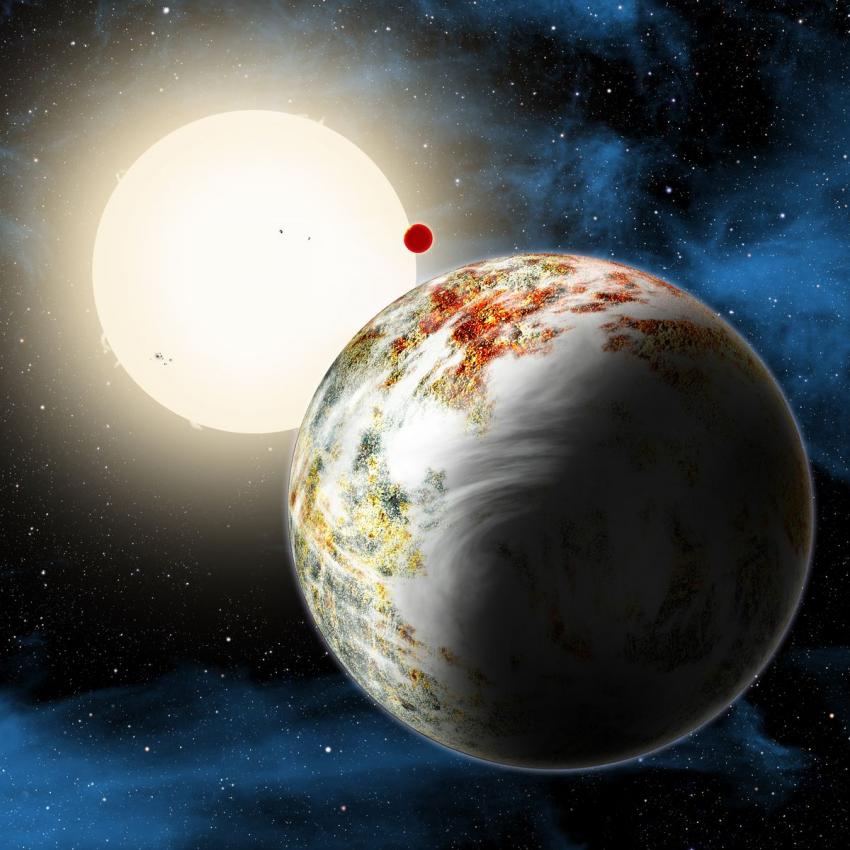Discovery of a Novel Planetary Type: The ‘Mega-Earth’ Detected by Astronomers
A new type of planet has been discovered by astronomers, which is a rocky world weighing 17 times more than Earth. This finding goes against the beliefs of theorists who thought that such a massive planet would accumulate hydrogen gas and become a gas giant like Jupiter. However, this planet is composed entirely of solids and is much larger than previously discovered “super-Earths,” earning it the name “mega-Earth.”
The lead astronomer, Xavier Dumusque of the Harvard-Smithsonian Center for Astrophysics (CfA), expressed surprise at the discovery, stating, “We were very surprised when we realized what we had found.” Dimitar Sasselov, a researcher at CfA and director of the Harvard Origins of Life Initiative, added, “This is the Godzilla of Earths! But unlike the movie monster, Kepler-10c has positive implications for life.”
The announcement of this finding was made during a press conference at a meeting of the American Astronomical Society (AAS).

The newly discovered mega-Earth, named Kepler-10c, orbits a star similar to our Sun once every 45 days. It is located approximately 560 light-years away from Earth in the constellation Draco. The planetary system also includes another planet called Kepler-10b, which is a “lava world” with a mass equivalent to three Earths and orbits its star in just 20 hours.Kepler-10c was initially detected by NASA’s Kepler spacecraft, which uses the transit method to find planets. This method involves observing a star’s dimming when a planet passes in front of it. By measuring the amount of dimming, astronomers can determine the physical size or diameter of the planet. However, Kepler cannot determine whether a planet is rocky or gaseous.
Kepler-10c, with a diameter of approximately 18,000 miles, is 2.3 times larger than Earth. This indicates that it belongs to the category of planets known as mini-Neptunes, characterized by their thick, gaseous envelopes.To determine the mass of Kepler-10c, the team utilized the HARPS-North instrument on the Telescopio Nazionale Galileo (TNG) located in the Canary Islands. Surprisingly, they discovered that it weighs 17 times more than Earth, exceeding initial expectations. This finding suggests that Kepler-10c possesses a dense composition consisting of rocks and other solid materials.
According to Dumusque, Kepler-10c did not lose its atmosphere over time and is sufficiently massive to retain one if it ever had it. This indicates that the planet must have formed in its current state.The formation of such a large rocky world poses challenges for planet formation theories. However, a recent observational study presented by CfA astronomer Lars A. Buchhave at AAS suggests that Kepler-10c is not an isolated case. Buchhave found a correlation between a planet’s period (the time it takes to orbit its star) and the point at which it transitions from a rocky composition to a gaseous one. This implies that as planet hunters expand their data to longer-period orbits, more mega-Earths like Kepler-10c are likely to be discovered.
The discovery that Kepler-10c is a mega-Earth holds significant implications for the history of the universe and the potential for life. The Kepler-10 system, which formed less than 3 billion years after the Big Bang, is approximately 11 billion years old. During the early stages of the universe, only hydrogen and helium were present. The heavier elements required for the formation of rocky planets, such as silicon and iron, had to be synthesized in the initial generations of stars. When these stars exploded, they dispersed these essential ingredients throughout space, which were later incorporated into subsequent generations of stars and planets.
The discovery of Kepler-10c suggests that the formation of rocky planets may have occurred much earlier than previously believed, despite the scarcity of heavy elements at that time. According to Sasselov, this finding indicates that if planets can form from rocks, the possibility of life also exists. Consequently, astronomers should not disregard older stars in their quest for Earth-like planets. By considering the potential for rocky Earths around old stars, the chances of identifying potentially habitable worlds in our cosmic vicinity are significantly improved.
This article is republished from PhysORG under a Creative Commons license. Read the original article.
Do not forget to share your opinion with us to provide you with the best posts !




0 Comments